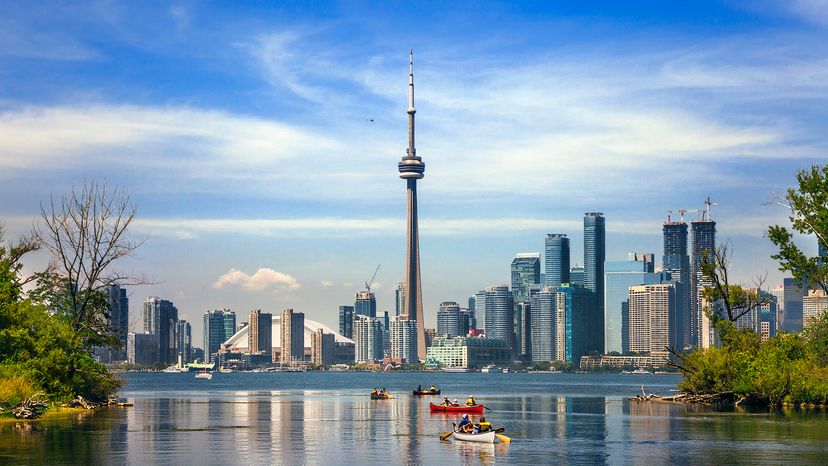Canada is a vast country with 10 unique provinces, each contributing to the nation's rich diversity in culture, economy and geography. While some provinces boast bustling cities and large populations, others are defined by their wide-open spaces and smaller communities. Let's take a look at the provinces, ranked by population.
1. Ontario (15.4 million)
Ontario is home to Canada's largest city, Toronto, and the nation's capital, Ottawa. With a population of 15.4 million, Ontario accounts for nearly 40 percent of Canada's total population.
It's a province of contrasts: The densely populated Southern Ontario region is a hub of financial and cultural activity, while the northern part of the province is sparsely populated, filled with lakes, forests and natural beauty.
Ontario has something for everyone, from the towering skyscrapers of Toronto to the serenity of Algonquin Park.
2. Quebec (8.7 million)
Next up is Quebec, comprising a population of 8.7 million people. Quebec is known for its distinct French-speaking culture, with Montreal and Quebec City serving as cultural hubs.
The province is steeped in history, with French traders being some of the first Europeans to settle here. While Quebec's urban agglomeration includes bustling cities, much of the province is dominated by forests, rivers and vast wilderness.
3. British Columbia (5.5 million)
With a population of 5.5 million, British Columbia is the third-largest province. Nestled between the Pacific Ocean and the Rocky Mountains, the province is known for its stunning natural beauty.
Vancouver, the province's largest city, is often ranked among the most livable cities in the world, thanks to its mild climate, outdoor recreational opportunities and vibrant cultural scene. From skiing in Whistler to hiking in the temperate rainforests, this region offers unparalleled access to nature, which draws in locals and tourists alike.
4. Alberta (4.5 million)
Alberta, with a population of 4.5 million, is known for its vast prairies and proximity to the Rocky Mountains. The province is home to two major cities: Calgary and Edmonton.
While Calgary is famous for its Stampede and as a host city for the Winter Olympics, Edmonton is the provincial capital and a hub of government and industry. Alberta is also the heart of Canada's oil industry, which has driven much of the province's growth and prosperity over the years.
5. Manitoba (1.4 million)
Manitoba may be known for its cold winters, but this prairie province is also home to 1.4 million people. Its capital city, Winnipeg, is a cultural and economic center, often referred to as the "Gateway to the West."
Manitoba's landscape is dominated by flat plains, but it also boasts thousands of lakes, making it a popular destination for fishing, boating and camping. The province has a rich Indigenous history and plays an important role in the country's agricultural sector.
6. Saskatchewan (1.2 million)
With a population of 1.2 million, Saskatchewan is known for its endless skies and golden wheat fields. While it may have fewer major cities than some other provinces, Regina and Saskatoon are cultural hubs, offering a mix of modern amenities and historical sites.
The North Saskatchewan River runs through Saskatoon, adding to the city's scenic charm. Agriculture and energy production are major industries here, contributing significantly to Canada's economy.
7. Nova Scotia (1 million)
Nova Scotia, with a population of about 1 million, is known for its maritime culture. Located on the country's east coast, this province is home to Halifax, one of the largest Canadian cities in the Atlantic region.
Nova Scotia is famous for its picturesque fishing villages, rugged coastline and historic lighthouses. The province also has a strong connection to the ocean, with industries like fishing, shipbuilding and tourism playing significant roles in the local economy.
8. New Brunswick (825,000)
With a population of 825,000, New Brunswick is a small but vibrant province located in the Maritimes. Known for its rolling hills, dense forests and stunning coastline along the Bay of Fundy, the province offers breathtaking views and outdoor activities.
Its largest city, Moncton, is an important center for transportation and commerce, while the capital city, Fredericton, houses the provincial government and has a rich cultural history.
9. Newfoundland and Labrador (522,000)
Though it's one of Canada's smallest provinces in terms of population, Newfoundland and Labrador (522,000 people) offers some of the most stunning natural landscapes in the world.
The province is home to St. John's, one of the oldest cities in North America, with colorful row houses and steep streets that reflect its deep Canadian history. The rugged coastline and vast, unspoiled wilderness make Newfoundland and Labrador a paradise for nature lovers.
10. Prince Edward Island (175,000)
Last but not least, Prince Edward Island may be the smallest province, both by population (175,000) and land area, but it packs a punch in charm. Known for its red sand beaches and rolling green hills, PEI is a popular summer destination for locals and tourists alike.
It's also famous for being the setting of "Anne of Green Gables." PEI's small towns and welcoming communities offer a unique glimpse into the slow-paced, island lifestyle that defines this province.



